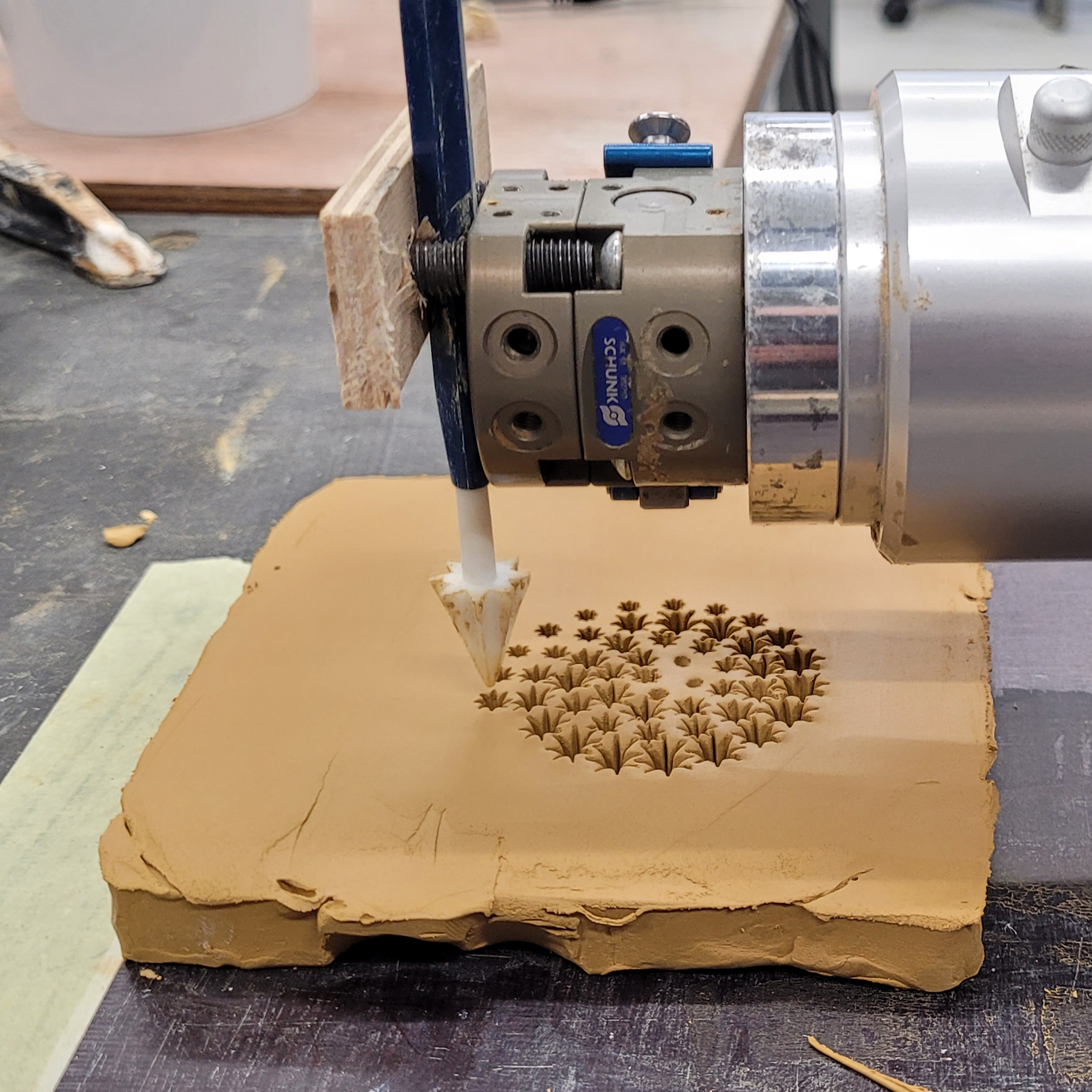Human–Material Dialogues Through the Use of Robotics
Embodied Craft Learning in an Architectural Educational Context Exploring Patterns in Clay
DOI:
https://doi.org/10.7577/formakademisk.5442Keywords:
Robotics, Craft, embodied learning, Human-material dialogue, ceramicsAbstract
This research investigates and discusses an embodied craft learning situation in an educational context that aims to support students within architecture by applying human–material dialogues when using robotics. Initially, the students were introduced to traditional craftsmanship based on materials and tools in ceramics. Based on the gained experiential knowledge, the same tools and materials were applied and explored on a UR 5 robot. A sensor provided the students with the opportunity to interact with the material through the robot while it was operating. The learning situation showed the potential to teach the students about robotics based on human–material dialogues and embodiment through making. The sensor enabled the students to use their experiential knowledge to improvise and work intuitively and spontaneously while they were exploring patterning based on the tools attached to the robot and the responsive material.
References
Binder, T., & Redström, J. (2006). Exemplary design research. In K. Friedman, T. Love, E. Côrte-Real, & C. Rust (Eds.), Wonderground – DRS International Conference (pp. 1–4). https://dl.designresearchsociety.org/drs-conference-papers/drs2006/researchpapers/51
Brinck, I., & Reddy, V. (2020). Dialogue in the making: Emotional engagement with materials. Phenomenology and the Cognitive Sciences, 19(1), 23–45. https://doi.org/10.1007/s11097-019-09629-2
DeLanda, M. (2004). Material complexity. In N. Leach, D. Turnbull, & C. Williams (Eds.), Digital techtonics (1st ed., pp. 14–21). Academy Press.
Dormer, P. (1994). The art of the maker. Thames and Hudson.
Downton, P. (2003). Design research. RMIT Press.
Dufva, T. S. (2018). Art education in the post-digital era - Experiential construction of knowledge through creative coding. https://doi.org/10.13140/RG.2.2.10040.85765
Falin, P., Horsanali, N., Hansen, F. T., & Mäkelä, M. (2021). Practitioners’ experience in clay 3D printing: Metaphorical viewing for gaining embodied understanding. FormAkademisk, 14(2), Article 2. https://doi.org/10.7577/formakademisk.4200
Johns, R. L., Kilian, A., & Foley, N. (2014). Design approaches through augmented materiality and embodied computation. In W. McGee & M. Ponce De Leon (Eds.), Robotic fabrication in architecture, art and design (pp. 319–332). Springer International Publishing. https://doi.org/10.1007/978-3-319-04663-1_22
Keep, J. (2019). Potting in a digital age. Studio Potter, 47(1). https://studiopotter.org/potting-digital-age
Koskinen, I., Binder, T., & Redström, J. (2008). Lab, field, gallery, and beyond. Artifact: Journal of Virtual Design - Artifact, 2, 46–57. https://doi.org/10.1080/17493460802303333
Leach, B. (1976). A potters book. Faber & Faber.
Ma, Z., Duenser, S., Schumacher, C., Rust, R., Bächer, M., Gramazio, F., Kohler, M., & Coros, S. (2020). RobotSculptor: Artist-directed robotic sculpting of clay. In Proceedings of the 5th Annual ACM Symposium on Computational Fabrication (pp. 1–12). https://doi.org/10.1145/3424630.3425415
McCullough, M. (1998). Abstracting craft. The practiced digital hand. MIT Press.
Pallasmaa, J. (2005). The eyes of the skin. Wiley-Academy.
Rheinberger, H.-J. (2012). Experimental systems: Difference, graphematicity, conjuncture. In F. Dombois, U. M. Bauer, C. Mareis, & M. Schwab (Eds.), Intellectual birdhouse: Artistic practice as research (pp. 89–99). König. https://hdl.handle.net/11858/00-001M-0000-002A-BC9D-9
Schön, D. (1983). The reflective practitioner. How professionals think in action. Temple Smith.
Sennett, R. (2008). The craftsman. Yale University Press.
Warnier, C., Verbruggen, D., Ehman, S., & Klanten, R. (2014). Printing things, visions and essentials for 3D printing. Gestalten.
Zoran, A., & Buechley, L. (2013). Hybrid reassemblage: An exploration of craft, digital fabrication and artifact uniqueness. Leonardo, 46, 4–10. https://doi.org/10.1162/LEON_a_00477

Downloads
Published
How to Cite
Issue
Section
License
Copyright (c) 2023 Flemming Tvede Hansen

This work is licensed under a Creative Commons Attribution-NoDerivatives 4.0 International License.
Authors who publish with this journal agree to the following terms:
- Authors retain copyright and grant the journal right of first publication with the work simultaneously licensed under a Creative Commons Attribution 4.0 License that allows others to share the work with an acknowledgement of the work's authorship and initial publication in this journal.
- Authors are able to enter into separate, additional contractual arrangements for the non-exclusive distribution of the journal's published version of the work (e.g., post it to an institutional repository or publish it in a book), with an acknowledgement of its initial publication in this journal.
- Authors are permitted and encouraged to post their work online (e.g., in institutional repositories or on their website) prior to and during the submission process, as it can lead to productive exchanges, as well as earlier and greater citation of published work (See The Effect of Open Access).
- The author(s) must manage their economic reproduction rights to any third party.
- The journal makes no financial or other compensation for submissions, unless a separate agreement regarding this matter has been made with the author(s).
- The journal is obliged to archive the manuscript (including metadata) in its originally published digital form for at least a suitable amount of time in which the manuscript can be accessed via a long-term archive for digital material, such as in the Norwegian universities’ institutional archives within the framework of the NORA partnership.
The material will be published OpenAccess with a Creative Commons 4.0 License which allows anyone to read, share and adapt the content, even commercially under the licence terms:
This work needs to be appropriately attributed/credited, a link must be provided to the CC-BY 4.0 licence, and changes made need to be indicated in a reasonable manner, but not in any way that suggests that the licensor endorses you or your use.



